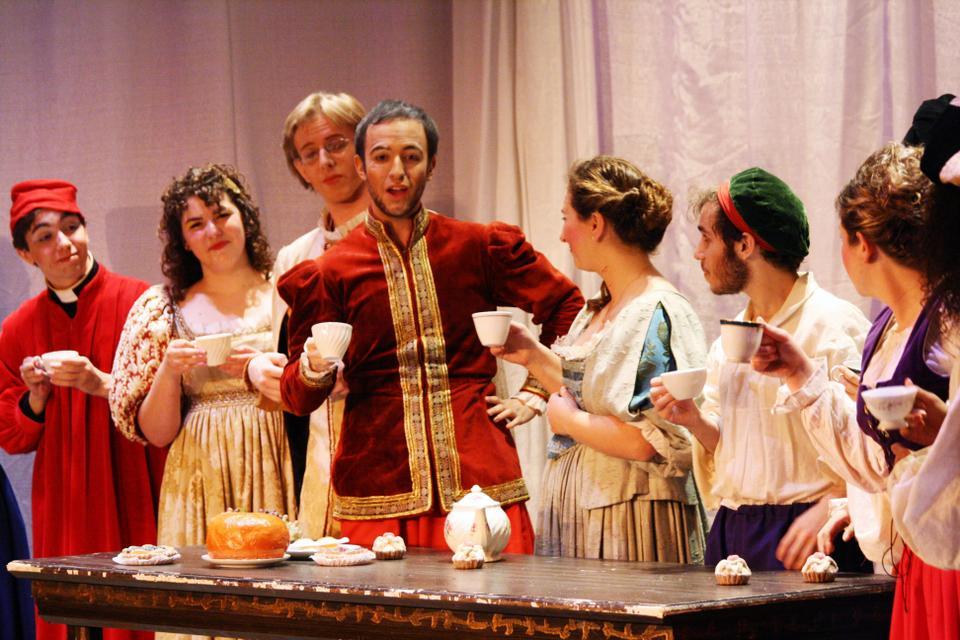
News
Summers Will Not Finish Semester of Teaching as Harvard Investigates Epstein Ties

News
Harvard College Students Report Favoring Divestment from Israel in HUA Survey

News
‘He Should Resign’: Harvard Undergrads Take Hard Line Against Summers Over Epstein Scandal

News
Harvard To Launch New Investigation Into Epstein’s Ties to Summers, Other University Affiliates

News
Harvard Students To Vote on Divestment From Israel in Inaugural HUA Election Survey
Cast of ‘Sorcerer’ Spellbinding

W.S. Gilbert and Arthur Sullivan’s “The Sorcerer,” running at the Agassiz Theatre through Sunday, is a rollicking romantic farce that centers on a magic love potion. As prepared by the Harvard-Radcliffe Gilbert and Sullivan Players, this theatrical elixir, despite somewhat uneven ingredients, surely casts its intended spell.
“The Sorcerer,” an early collaboration between Gilbert and Sullivan, tells the story of an idealistic young nobleman, Alexis Pointdextre (a role shared by Benjamin J. Nelson ’11 and Zander J. MacQuitty ’10), who decides, on the eve of his wedding to Aline (Marit A. Medefind ’12), that he wants all the citizens of his village to share in the bliss of love. Hoping to realize this plan, he hires a professional wizard (Nathaniel Koven) to brew a love potion for all to drink. Hilarious chaos ensues. As a range of characters, including Alexis’ father Sir Marmaduke Pointdextre (Michael A. Yashinsky ’11, who is also a Crimson Arts comper) and Aline’s mother Lady Sangazure (Sofia M. Selowsky ’12) fall madly and inexplicably in love with whomever they first behold after drinking the philter.
This characteristically absurd plot requires an adroit handling of Sullivan’s appealing music, which Music Director Jesse C. Wong ’12 provides admirably. The orchestra plays with real verve, supporting the singers while maintaining a strong presence. The six-person chorus, too, sings well and energetically.
The success of a show like “The Sorcerer,” with a fundamentally weak plot only resolved by a deus ex machina, depends largely on its soloists, whom stage director Davida Fernandez-Barkan ’11 manages effectively. The role of Alexis is well handled by Nelson (in last Saturday’s matinee performance). His strong tenor and zestful portrayal of his foppish, affected character provides many of the performance’s most rewarding moments. In particular, his over-the-top exchanges with his father, played with great aplomb by Yashinsky, are delightful.
Medefind also gives a very effective performance as Aline. The role offers limited dramatic opportunities, but Medefind’s light yet textured soprano brings great charisma to the part, especially in the song “My Kindly Friends/Happy Young Heart.” Selowsky shines as Lady Sangazure, combining vocal agility with dramatic sensitivity. Her rich timbre and mature legato stand out particularly in her aria “My Child, I Join in These Congratulations” and her duet with Sir Marmaduke, “Welcome, Joy!”
Despite only making a few appearances, the titular sorcerer is perhaps the operetta’s most memorable role, and Koven certainly delivers, blazing through the patter song “My Name is John Wellington Wells” and eliciting gasps of delight from the many children in the audience during his other numbers. As Koven seems to understand, the character’s distinctive combination of weird and respectable qualities exemplifies Gilbert and Sullivan’s preoccupation with juxtaposing the ironic and absurd.
In supporting roles, the warm baritone of Robert A. Knoll ’13 lends humanity to the lonely vicar Dr. Daly. The mother-daughter pair of Mrs. Parlet (Amrita S. Dani ’13) and Constance (Megan M. Savage ’10), two excessively emotional villagers, also give solid comic turns. And when the entire ensemble appears together in the finales to both acts, the performers’ shared delight in the music creates a wonderful, tangible energy.
Perhaps attempting to capitalize on this gaiety, the production incorporates the choreography of Antonia M. Pugliese ’12, with varying success. In particular, during Sir Marmaduke and Lady Sangazure’s duet “Welcome, Joy!” the busy movements distract from the comic interaction between the two self-important aristocrats. But the chorus dances well in a number of scenes, adding to the production’s festive feel.
The show’s peripheral elements serve to provide a solid background to its comic madness. The lighting design of Tiffany M. Bradshaw ’10 contributes effectively to the mood, despite a chaotic and disorienting series of color changes near the finale. The gaudy Elizabethan costumes, created by Pugliese, further add to the production’s merrily boisterous feel.
Fernandez-Barkan ably handles this topsy-turvy romance, drawing out the wit of Gilbert’s libretto as Wong gives Sullivan’s music its due. “The Sorcerer” may be a light opera from Victorian England, but, thanks to this production’s charms, the work still amuses today.
Want to keep up with breaking news? Subscribe to our email newsletter.
